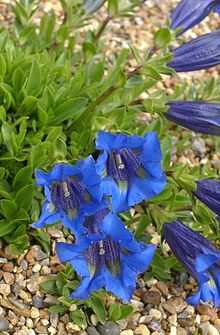Gentianaceae
| Gentian family | |
|---|---|
 | |
| Gentiana acaulis | |
| Scientific classification | |
| Kingdom: | Plantae |
| (unranked): | Angiosperms |
| (unranked): | Eudicots |
| (unranked): | Asterids |
| Order: | Gentianales |
| Family: | Gentianaceae Juss.[1] |
| Type genus | |
| Gentiana L. | |
Gentianaceae is a family of flowering plants of 87 genera and about 1600 species.[2]
Etymology
The family takes its name from the genus Gentiana, named after the Illyrian king Gentius.
Distribution
Distribution is cosmopolitan.
Characteristics
The family consists of trees, shrubs and herbs showing a wide range of colours and floral patterns. Flowers are actinomorphic and bisexual with fused sepals and petals. The stamens are attached to the inside of the petals (epipetalous) and alternate with the corolla lobes. There is a glandular disk at the base of the gynoecium, and flowers have parietal placentation. The inflorescence is cymose, with simple or complex cymes. The fruits are dehiscent septicidal capsules splitting into two halves, rarely some species have a berry. Seeds are small with copiously oily endosperms and a straight embryo. The habit varies from small trees, pachycaul shrubs to (usually) herbs, with ascending, erect or twining stems. Plants are usually rhizomatous. Leaves opposite, less often alternate or in some species whorled, simple in shape, with entire edges and bases connately attached to the stem. Stipules are absent. Plants usually accumulate bitter iridoid substances; bicollateral bundles are present. Ecologically, partial myco-heterotrophy is common among species in this family with a few genera such as Voyria and Voyriella lacking chlorophyll and being fully myco-heterotrophic.
Ecology
Some of these plants have limited ranges and are protected under governmental oversight. For example, Gentianella uliginosa (Dune Gentian), which occurs in some limited areas of Wales and Scotland, is a priority species under the Biodiversity Action Plan of the United Kingdom.[citation needed]
Uses
Economically, some species are cultivated ornamental plants and many species yield bitter principles used medicinally and in flavorings.
Taxonomy
The family was described for the first time by Antoine Laurent de Jussieu in 1789.
Tribes
- tribe Chironieae (G.Don) Endl.
- tribe Exaceae Colla
- tribe Gentianeae Colla
- subtribe Gentianinae G.Don
- subtribe Swertiinae (Griseb.) Rchb.
- tribe Helieae Gilg
- tribe Potalieae Rchb.
- tribe Saccifolieae (Maguire & Pires) Struwe, Thiv, V.A.Albert & Kadereit
- incertae sedis Voyria
Genera
- Adenolisianthus (Progel) Gilg
- Anthocleista R.Br.
- Aripuana Struwe, Maas & V.A.Albert
- Bartonia H.L.Mühl. ex Willd.
- Bisgoeppertia Kuntze
- Blackstonia Huds.
- Calolisianthus Gilg
- Canscora Lam.
- Celiantha Maguire
- Centaurium Hill
- Chelonanthus Gilg
- Chironia L.
- Chorisepalum Gleason & Wodehouse
- Cicendia Adans.
- Comastoma (Wettst.) Toyok.
- Congolanthus A.Raynal
- Cotylanthera Blume
- Coutoubea Aubl.
- Cracosna Gagnep.
- Crawfurdia Wall.
- Curtia Cham. & Schltdl.
- Deianira Cham. & Schltdl.
- Djaloniella P.Taylor
- Enicostema Blume
- Eustoma Salisb.
- Exaculum Caruel
- Exacum L.
- Fagraea Thunb.
- Faroa Welw.
- Frasera Walter
- Geniostemon Engelm. & A.Gray
- Gentiana L.
- Gentianella Moench
- Gentianopsis Ma
- Gentianothamnus Humbert.
- Halenia Borkh.
- Helia Mart.
- Hockinia Gardner
- Hoppea Willd.
- Irlbachia Mart.
- Ixanthus Griseb.
- Jaeschkea Kurz
- Karina Boutique
- Lagenanthus Gilg
- Latouchea Franch.
- Lehmanniella Gilg
- Lisianthius P.Browne
- Lomatogonium A.Braun
- Macrocarpaea (Griseb.) Gilg
- Megacodon (Hemsl.) Harry Sm.
- Microrphium C.B.Clarke
- Neblinantha Maguire
- Neurotheca Salisb. ex Benth.
- Obolaria L.
- Oreonesion A.Raynal
- Ornichia Klack.
- Orphium E.Mey.
- Phyllocyclus Kurz
- Potalia Aubl.
- Prepusa Mart.
- Pterygocalyx Maxim.
- Purdieanthus Gilg
- Pycnosphaera Gilg
- Rogersonanthus Maguire & Pires
- Sabatia Adans.
- Saccifolium Maguire & Pires
- Schinziella Gilg
- Schultesia Mart.
- Sebaea Sol. ex R.Br.
- Senaea Taub.
- Sipapoantha Maguire & B.M.Boom
- Swertia L.
- Symbolanthus G.Don
- Tachia Aubl.
- Tachiadenus Griseb.
- Tapeinostemon Benth.
- Tetrapollinia Maguire & B.M.Boom
- Tripterospermum Blume
- Urogentias Gilg & Gilg-Ben.
- Veratrilla Baill. ex Franch.
- Voyria Aubl.
- Voyriella Miq.
- Wurdackanthus Maguire
- Xestaea Griseb.
- Zonanthus Griseb.
- Zygostigma Griseb.
Phylogeny
| Gentianaceae |
| |||||||||||||||||||||||||||
| |
References
- ↑ Angiosperm Phylogeny Group (2009). "An update of the Angiosperm Phylogeny Group classification for the orders and families of flowering plants: APG III" (PDF). Botanical Journal of the Linnean Society 161 (2): 105–121. doi:10.1111/j.1095-8339.2009.00996.x. Retrieved 2013-07-06.
- ↑ Struwe L, Albert VA (2002). Gentianaceae: systematics and natural history. Cambridge University Press. ISBN 0-521-80999-1.